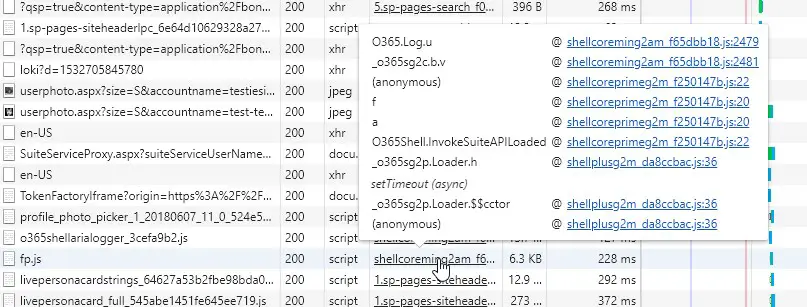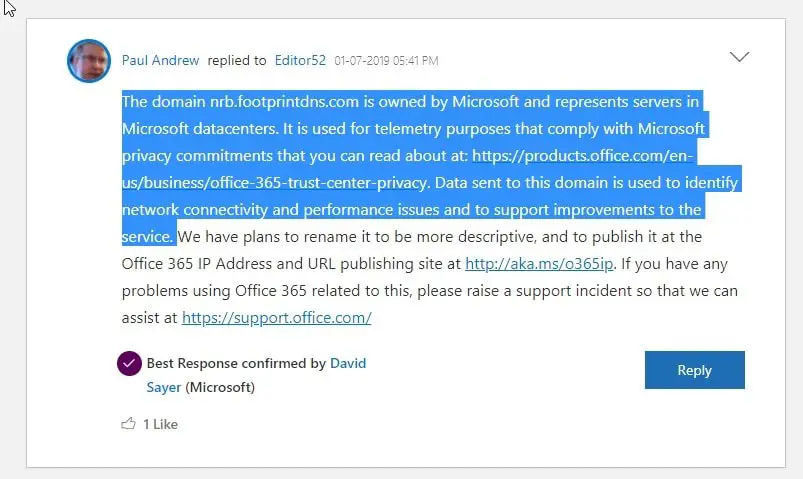This post was most recently updated on March 28th, 2023.
12 min read.Microsoft is gathering all kinds of telemetric data out of the usage of SharePoint. I ran into an interesting JavaScript file, fp.js, on SharePoint Online doing just that and gathering data.
It loads on pretty much every single page request, so it’s something you’ll bump into any time you open your developer tools! Your customer’s IT might even inquire about it – perhaps wanting to disable it for performance or information security gains.
But what is fp.js and what does it do?
Background
This is similar to the requests to WsaUpload.ashx, that I’ve written about earlier:
I encountered this unscrambled, unminified JavaScript code snooping on me on all of the tenants I opened. That was a bit surprising, to say the least – it’s considered good practice to make your files as tiny as possible if they’re going to be loaded on each and every page load for each and every user. Even if the difference in file size would only be 10kb, that’s going to amount to a huge pile of kilobytes in the long run, with millions of people loading tens or hundreds of millions of SharePoint pages.
Anyway, here’s the whole file for your reference (because who knows when Microsoft will wisen up and at least minify it!)
var fpconfig = {
n: 3,
e: [
{ e: "atm-fp-direct.office.com", w: 20, m: 128 },
{ e: "a-ring.msedge.net", w: 20, m: 1 },
{ e: "b-ring.msedge.net", w: 20, m: 1 },
{ e: "k-ring.msedge.net", w: 20, m: 1 },
{ e: "ow1.res.office365.com", w: 20, m: 1 },
{ e: "afd-a-acdc-direct.office.com", w: 20, m: 1 },
{ e: "afd-k-acdc-direct.office.com", w: 20, m: 1 },
{ e: "acdc-direct.office.com", w: 20, m: 128 },
{ e: "gtm-dyn-direct.office365.com", w: 20, m: 128 },
{ e: "outlook.office365.com", w: 20, m: 128 },
{ e: "outlook.office.com", w: 20, m: 1 },
{ e: "outlook.live.com", w: 20, m: 1 },
{ e: "substrate.office.com", w: 20, m: 1 },
{ e: "*.nrb.footprintdns.com", w: 1e6, m: 1 }
],
r: ["fpc.msedge.net/r.gif", "footprintc.azureedge.net/r.gif"]
};
Footprint = (function () {
var IMG_FETCH_HTTPS_FLAG = 1; // measurement type for img fetch https
var IMG_FETCH_HTTP_FLAG = 2; // measurement type for img fetch http
var IMG_FETCH_FLAGS = IMG_FETCH_HTTPS_FLAG | IMG_FETCH_HTTP_FLAG;
var THROUGHPUT_HTTPS_FLAG = 8; // measurement type for throughput https
var THROUGHPUT_HTTP_FLAG = 16; // measurement type for throughput http
var THROUGHPUT_FLAGS = THROUGHPUT_HTTPS_FLAG | THROUGHPUT_HTTP_FLAG;
var IMG_FLAGS = IMG_FETCH_FLAGS | THROUGHPUT_FLAGS;
var XHR_FETCH_HTTPS_FLAG = 128; // measurement type for xhr fetch https
var XHR_FETCH_HTTP_FLAG = 256; // measurement type for xhr fetch http
var XHR_FETCH_FLAGS = XHR_FETCH_HTTPS_FLAG | XHR_FETCH_HTTP_FLAG;
var FETCH_FLAGS = IMG_FETCH_FLAGS | XHR_FETCH_FLAGS;
var HTTP_PROT = "http://"; // identifies the HTTP scheme
var HTTPS_PROT = "https://"; // identifies the HTTPS scheme
var MAX_TAG_LENGTH = 200; // 200 characters is defined in the FPv1 spec as the maximum tag length.
var WARMUP_IMG = "trans.gif"; // 1x1 image used for DNS warmup
var MEASUREMENT_OBJ_PATH = "/apc/"; // fetch remote images from this path
var REQUEST_TIMEOUT = 5000; // The number of milliseconds to wait before giving up on a request and marking it failed.
var LATENCY_IMG = "trans.gif"; // image used for latency measurements
var THROUGHPUT_IMG = "100k.gif"; // image used for throughput measurements
var THROUGHPUT_LEN_KILOBITS = 822.128; // = 102766 * 8 / 1000.0. Bytes to bits and then kilobits
var MILLIS_IN_SECOND = 1000.0; // milliseconds in a second
var GET_METHOD = "GET";
var POST_METHOD = "POST";
var ERROR_VALUE = -1; // result value returned on error
var REPORT_VERSION = "2018031301";
var USERHOSTADDRESS_HEADER = "x-userhostaddress";
var ENDPOINT_HEADER = "x-endpoint";
/**
* Begins the Footprint measurements.
*
* @param monitorID A unique identifier for the application running this client code.
* @param configUrls A list of URLs that host footprint configuration for this client.
* @param requestDelay The delay in milliseconds until measurements will start.
* @param tag Optional. A string that will be logged and persisted for offline correlation. Truncated to 200 characters.
* @param customerId Optional. A unique identifier for the customer requesting the measurement, relevant to the application running this client.
*/
function start(monitorID, configUrls, requestDelay, tag, customerId) {
if (tag === void 0) { tag = ""; }
if (customerId === void 0) { customerId = ""; }
// Validate input parameters.
// - monitorID should be a non-empty string.
// - requestDelay should be a positive integer.
if (!monitorID || monitorID.trim().length === 0 || Number(requestDelay) !== requestDelay || requestDelay % 1 !== 0 || requestDelay < 0) {
return;
}
var customerIdDefined = (customerId.trim().length > 0);
var tagExists = (tag.trim().length > 0);
// check if we need to truncate the tag.
if (tagExists && tag.trim().length > MAX_TAG_LENGTH) {
tag = tag.trim().substr(0, MAX_TAG_LENGTH);
}
var localProtocol = window.location.protocol + "//";
// Give up on this measurement if the browser does not support the JSON or XMLHttpRequest module.
if (!JSON || !XMLHttpRequest) {
return;
}
// Give up on this measurement if the browser does not support the below functions of XMLHttpRequest
var xhrCheck = new XMLHttpRequest();
if (!('onload' in xhrCheck) || !('onerror' in xhrCheck) || !('ontimeout' in xhrCheck) || !('getAllResponseHeaders' in xhrCheck)) {
return;
}
var w3cEnabled = w3cResourceEnabled();
var reportId = probeId(); // uniqely identifies this measurement report
var reportParams = "MonitorID=" + monitorID + (customerIdDefined ? "&customerId=" + customerId : "") + "&rid=" + reportId + "&w3c=" + w3cEnabled + "&prot=" + window.location.protocol + "&v=" + REPORT_VERSION + (tagExists ? "&tag=" + tag : "") + "&DATA=";
// Function that configures the measurements and begins the flight
var configureAndRun = function () {
var configuration = configureMeasurements(fpconfig, localProtocol); // configure measurements from config
if (configuration.length === 0) {
return; // exit if no measurements can be run from this client
}
var urls = generateMeasurements(configuration, localProtocol, WARMUP_IMG);
var reportUrls = []; // URLs to which probe data will be reported
for (var _i = 0, _a = fpconfig.r; _i < _a.length; _i++) {
var reportEndpoint = _a[_i];
reportUrls.push(localProtocol + reportEndpoint + "?" + reportParams);
}
flight(urls, REQUEST_TIMEOUT, requestDelay, reportUrls, null);
};
if (typeof fpconfig === "undefined") {
for (var i in configUrls) {
configUrls[i] = localProtocol + configUrls[i] + "?" + ("monitorId=" + monitorID + (customerIdDefined ? "&customerId=" + customerId : ""));
}
var configRequestComplete = function (req) {
fpconfig = JSON.parse(req.responseText);
configureAndRun();
};
fallbackRequest(configUrls, 0, GET_METHOD, configRequestComplete);
}
else {
configureAndRun();
}
}
/**
* Makes XHR to the input urls until a request is successful or all urls have been attempted.
*
* @param urls An array of URLs to make requests to.
* @param urlIndex The index of the URL that will be tested.
* @param method The http method. "GET" or "POST"
* @param onComplete The function callback on a successful request. Since this function returns
* after a successful request, this function will only be called once.
*/
function fallbackRequest(urls, urlIndex, method, onComplete) {
if (urlIndex >= urls.length) {
return;
}
if (method !== GET_METHOD && method !== POST_METHOD) {
method = GET_METHOD;
}
var failure = function () {
fallbackRequest(urls, urlIndex + 1, method, onComplete);
};
var req = new XMLHttpRequest();
req.open(method, urls[urlIndex], true);
req.onload = function () {
if (req.readyState === 4 && req.status === 200) {
if (onComplete != null) {
onComplete(req);
}
}
else {
failure();
}
};
req.onerror = failure;
req.timeout = REQUEST_TIMEOUT;
req.ontimeout = failure;
req.send();
}
/**
* Selects which measurements will be executed based on the input footprint configuration.
*
* @param fpconfig The Footprint configuration.
* @param localProtocol The protocol of the host page. E.g. "http://" or "https://"
* @return Array of configuration objects containing measurement id and testImage properties.
*/
function configureMeasurements(fpconfig, localProtocol) {
var idsWithWeights = [];
var totalWeight = 0;
// Select all possible measurements that can be executed (fetch and throughput)
var fetchAndThroughputFlags = FETCH_FLAGS | THROUGHPUT_FLAGS;
for (var _i = 0, _a = fpconfig.e; _i < _a.length; _i++) {
var entry = _a[_i];
if (entry.w > 0 && entry.m & fetchAndThroughputFlags) {
totalWeight += entry.w;
idsWithWeights.push({ "endpoint": entry.e, "cumWeight": totalWeight, "weight": entry.w, "measurementTypes": entry.m });
}
}
var acceptedFlags = localProtocol.toLowerCase() === HTTP_PROT ?
[IMG_FETCH_HTTP_FLAG, THROUGHPUT_HTTP_FLAG, XHR_FETCH_HTTP_FLAG] :
[IMG_FETCH_HTTPS_FLAG, THROUGHPUT_HTTPS_FLAG, XHR_FETCH_HTTPS_FLAG];
var testImages = [LATENCY_IMG, THROUGHPUT_IMG, LATENCY_IMG];
var ranks = [1, 3, 2];
var config = [];
var idCount = Math.min(fpconfig.n, idsWithWeights.length);
for (var id = 0; id < idCount; id++) {
var randomWeight = Math.floor(Math.random() * totalWeight);
var randomItem = null;
for (var i = 0; i < idsWithWeights.length; i++) {
if (randomItem == null) {
if (randomWeight < idsWithWeights[i].cumWeight) {
randomItem = idsWithWeights[i];
/* Don't break here to finish adjusting the weights of remaining items.
Make the cumWeight of this item 0 so it will never be picked again */
idsWithWeights[i].cumWeight = 0;
}
}
else {
/* Since we found an item, all of the subsequent items need to subtract the
selected items weight from their cumulative weight */
idsWithWeights[i].cumWeight -= randomItem.weight;
}
}
totalWeight -= randomItem.weight; // subtract the weight of the selected item from the total
var guid = randomItem.endpoint.charAt(0) === "*" ? probeId() : ""; // generate a new guid for each endpoint that has a wildcard
for (var i = 0; i < acceptedFlags.length; i++) {
if (randomItem.measurementTypes & acceptedFlags[i]) {
config.push({ "id": randomItem.endpoint, "testImage": testImages[i], "measurementType": acceptedFlags[i], "guid": guid, "rank": ranks[i] });
}
}
}
config.sort(function (a, b) { return a.rank - b.rank; });
return config;
}
/**
* Generates the measurement URLs based on the input configuration.
*
* @param measurementConfigs Array of config objects containing an endpoint id, testImage, measurementType, guid, and rank.
* @param localProtocol The protocol of the host page. E.g. "http://" or "https://"
* @param warmupImg the image to be fetched for measurement warmup
* @return Array of measurement objects containing url, requestID, object, conn, measurementType and report properties.
*/
function generateMeasurements(measurementConfigs, localProtocol, warmupImg) {
var urlIds = [];
for (var _i = 0, measurementConfigs_1 = measurementConfigs; _i < measurementConfigs_1.length; _i++) {
var config = measurementConfigs_1[_i];
var measurementType = config.measurementType;
var testImg = config.testImage; // the image that will have its download latency reported
var guid = config.guid;
var id = config.id;
var testurl = localProtocol + id;
if (id.indexOf(".") === -1) {
testurl += ".clo.footprintdns.com"; // for backwards compatibility with FPv1
}
else if (id.charAt(0) === "*") {
var fqdn = id.substring(2); // get the everything after the "*."
testurl = localProtocol + guid + "." + fqdn; // the id does have a dot so we assume it to be a FQDN.
id = (fqdn === "clo.footprintdns.com" || fqdn === "nrb.footprintdns.com" || fqdn === "azr.footprintdns.com") ? guid : fqdn; // If the id ends with these hostnames then the requestID will be the guid, otherwise it will be the FQDN.
}
testurl += MEASUREMENT_OBJ_PATH;
var coldUrl = testurl + warmupImg + "?" + probeId();
var reportCold = (measurementType & THROUGHPUT_FLAGS) !== measurementType; // don't report cold measurement for throughput. It may not be cold if the same endpoint was measured already.
urlIds.push({ "url": coldUrl, "requestID": id, "object": warmupImg, "conn": "cold", "measurementType": measurementType, "report": reportCold });
var warmUrl = testurl + testImg + "?" + probeId();
urlIds.push({ "url": warmUrl, "requestID": id, "object": testImg, "conn": "warm", "measurementType": measurementType, "report": true });
}
return urlIds;
}
/**
* Format measurement results into JSON string.
* @param loadTimes raw latency measurements
* @param urlIds measurement data associated with each latency measurement
*/
function createReport(loadTimes, userHostAddresses, endPoints, urlIds) {
//list of result objects
var results = [];
for (var i = 0; i < urlIds.length; i++) {
if (!urlIds[i].report) {
continue; // skip measurement if report is false
}
var rawLatency = loadTimes[i];
var measurementType = urlIds[i].measurementType;
var processedMeasurement = createMeasurementResult(rawLatency, measurementType);
var result = {};
result.RequestID = urlIds[i].requestID;
result.Object = urlIds[i].object;
result.Conn = urlIds[i].conn;
result.Result = processedMeasurement;
result.T = measurementType;
if (userHostAddresses[i]) {
result.Rip = userHostAddresses[i];
}
if (endPoints[i]) {
result.Ep = endPoints[i];
}
results.push(result);
}
return JSON.stringify(results);
}
/**
* Convert a raw latency value into its reportable form.
* @param rawLatencyMillis
* @param measurementType
*/
function createMeasurementResult(rawLatencyMillis, measurementType) {
if (rawLatencyMillis <= 0) {
return rawLatencyMillis;
}
if (measurementType & THROUGHPUT_FLAGS && rawLatencyMillis > 0) {
var kbps = THROUGHPUT_LEN_KILOBITS / (rawLatencyMillis / MILLIS_IN_SECOND);
return Math.round(kbps);
}
return Math.round(rawLatencyMillis);
}
/*
* Generates an RFC4122 version 4 GUID to identify individual probes.
* "-"s are left out of the GUID so that it remains alphanumeric only.
*/
function probeId() {
function s4() {
return Math.floor((1 + Math.random()) * 0x10000).toString(16).substring(1);
}
return s4() + s4() + s4() + s4() + s4() + s4() + s4() + s4();
}
/*
* Checks if the browser has W3C resource timing enabled.
*/
function w3cResourceEnabled() {
return (window.performance && window.performance.getEntriesByName) ? true : false;
}
/**
* Runs a measurement test for a user provided list of URLs and sends a JSON report
* back to a report server.
*/
function flight(urls, reqTimeout, reqDelay, reportUrls, onComplete) {
var loadTimes = [];
var userHostAddresses = [];
var endPoints = [];
for (var i = 0; i < urls.length; i++) {
loadTimes[i] = ERROR_VALUE;
userHostAddresses[i] = null;
endPoints[i] = null;
}
function errorHandler(index) {
// Skip warm measurement if cold measurement failed
if (urls[index].conn === "cold") {
urls[index + 1].report = false; // don't report warm measurement
doProbe(index + 2); // don't perform warm measurement
}
else {
doProbe(index + 1);
}
}
// Used in the case that endpoint doesn't support CORS
function doImgProbe(index) {
var timeoutId;
var img = new Image;
img.onload = function () {
loadTimes[index] = new Date().getTime() - startTime;
// clear timeout
if (timeoutId) {
clearTimeout(timeoutId);
}
doProbe(index + 1);
};
img.onerror = function () {
// clear timeout
if (timeoutId) {
clearTimeout(timeoutId);
}
errorHandler(index);
};
// Configure to give up on the load after reqTimeout ms.
timeoutId = setTimeout(function () {
// clear event handlers
img.onload = null;
img.onerror = null;
errorHandler(index);
}, reqTimeout);
var startTime = new Date().getTime();
img.src = urls[index].url;
}
// Used in the case that endpoint supports CORS
function doXhrProbe(index) {
var xhr = new XMLHttpRequest();
xhr.open(GET_METHOD, urls[index].url, true);
xhr.onload = function () {
if (xhr.readyState === 4) {
if (xhr.status === 200) {
loadTimes[index] = new Date().getTime() - startTime;
// Get the raw header string
var rawHeader = xhr.getAllResponseHeaders();
if (rawHeader) {
// Convert the header string into an array of individual headers
var headers = rawHeader.split('\r\n');
headers.forEach(function (line) {
var parts = line.split(':');
if (parts.length === 2) {
var header = parts[0].trim().toLowerCase();
var value = parts[1].trim();
if (header === USERHOSTADDRESS_HEADER) {
userHostAddresses[index] = value;
}
else if (header === ENDPOINT_HEADER) {
endPoints[index] = value;
}
}
});
}
doProbe(index + 1);
}
else {
loadTimes[index] = 0 - xhr.status;
errorHandler(index);
}
}
else {
errorHandler(index);
}
};
xhr.onerror = function () {
errorHandler(index);
};
xhr.ontimeout = function () {
errorHandler(index);
};
// Configure to give up on the load after reqTimeout ms.
xhr.timeout = reqTimeout;
var startTime = new Date().getTime();
xhr.send();
}
var generateReportAndUpload = function () {
if (reportUrls != null && reportUrls.length !== 0) {
/*
Generate a report.
First look for W3C resource timings and then fall back to less
accurate timing if W3C is not supported in this browser.
Second check because Firefox doesn'cumWeight support resource timing yet.
*/
if (w3cResourceEnabled()) {
// Find W3C timing for URLs in urlsToTest. Update loadTime Array.
for (var i_1 = 0; i_1 < urls.length; i_1++) {
var testUrl = urls[i_1].url;
var perfEntryArray = window.performance.getEntriesByName(testUrl);
/*
Only update the loadTime for this testUrl if the value is not negative
from a timeout or error. Otherwise, it will fill in the time it took
to return a 404, for example.
*/
if (loadTimes[i_1] >= 0 && perfEntryArray && perfEntryArray[0]) {
/*
Resources fetched from cross domains only have limited timing information available,
startTime, fetchTime, duration, and responseEnd. duration = responseEnd - startTime.
*/
loadTimes[i_1] = perfEntryArray[0].duration;
}
}
}
var reportStr = createReport(loadTimes, userHostAddresses, endPoints, urls); // Create JSON data report
var reportRequests = [];
for (var j = 0; j < reportUrls.length; j++) {
var reportRequest = reportUrls[j] + reportStr;
reportRequests.push(reportRequest);
}
fallbackRequest(reportRequests, 0, GET_METHOD, null);
}
};
// start with index 0 from urls since we assume that the measurements are ordered as cold, hot, cold, hot, ...
// the configureMeasurements now takes care of starting points across measurements
function doProbe(index) {
if (index < urls.length) {
if (urls[index].measurementType & IMG_FLAGS) {
doImgProbe(index);
}
else {
doXhrProbe(index);
}
}
else {
generateReportAndUpload();
// Execute onComplete function now that probes are finished
if (onComplete != null) {
onComplete();
}
}
}
// wait for reqDelay(ms) to prevent confusing page load events of the parent page
// or delaying things the page itself wants to do when it finishes loading
setTimeout(function () { doProbe(0); }, reqDelay);
}
// The public API for the Footprint module
return {
start: start
};
})();
[/symple_toggle]
So what does it do, then?
I’m guessing that fp.js stands for “fingerprint”.js. I mean… That’s what it says in the file, too :)
The file is one of many used by Microsoft for different analytics purposes. There are a bunch of different variants you might encounter – but this blog post describes the one you can find on Modern SharePoint sites.
The file seems to gather some simple information and usage analytics from the users.

 fp.js in the Network tab of your browser
fp.js in the Network tab of your browserSo – you’d think having unminified JavaScript libraries for snooping purposes isn’t super optimal? Well, it isn’t. The file should at least be compressed and minified, even if only to save some bandwidth.
The file itself makes requests to this domain:
- nrb.footprintdns.com
… which is owned and maintained by Microsoft for analytics purposes.
This was confirmed on Tech Community:
The domain nrb.footprintdns.com is owned by Microsoft and represents servers in Microsoft datacenters. It is used for telemetry purposes – – Data sent to this domain is used to identify network connectivity and performance issues and to support improvements to the service.
Paul Andrew (MSFT) 7.1.2019
(see below for a screenshot of the same)

https://techcommunity.microsoft.com/t5/SharePoint/What-is-the-domain-quot-nrb-footprintdns-com-quot/td-p/170502
Surprisingly, this is not listed on Office 365’s public IP ranges and DNS names document. Quite an oversight by Microsoft!
At the time of posting this, the last comment in the thread on 14.1.2019 is Microsoft’s recommendation to contact Microsoft Support if fingerprinting activities etc. cause performance issues. It would be interesting to hear what kind of responses people have gotten for that complaint… :)
How to block it?
I don’t currently know of a supported / safe way to block it. There is no switch for that.
Moreover, it’s a fairly harmless file. If Microsoft is gathering usage statistics for their products, as long as they’re not causing performance degradations or invading your privacy, let them.
However, you can always use a browser plug-in to block it (some plug-ins probably already block it by default), block it at the network level, locally block the domain using the host’s file, or even inject custom JavaScript to stop the file from functioning.
None of these should be considered safe or supported solutions, so unless you have a good reason, don’t worry about the file too much :) There are plenty of bigger performance issues associated with a typical SharePoint deployment to worry about, after all!
References
- How to generate Certificate-Signing Requests using OpenSSL - June 18, 2024
- Home Assistant 2024.4 changes weather forecasts – what to do? - June 11, 2024
- External path “**” cannot have more than one “*” wildcard with vite? - June 4, 2024




